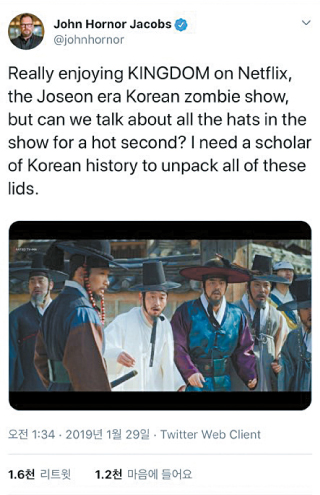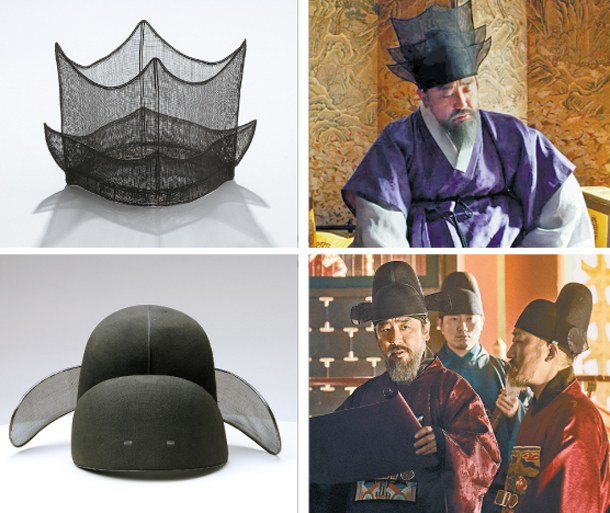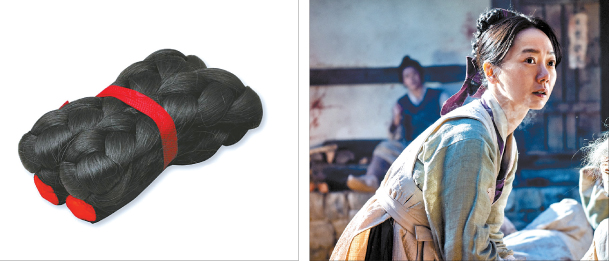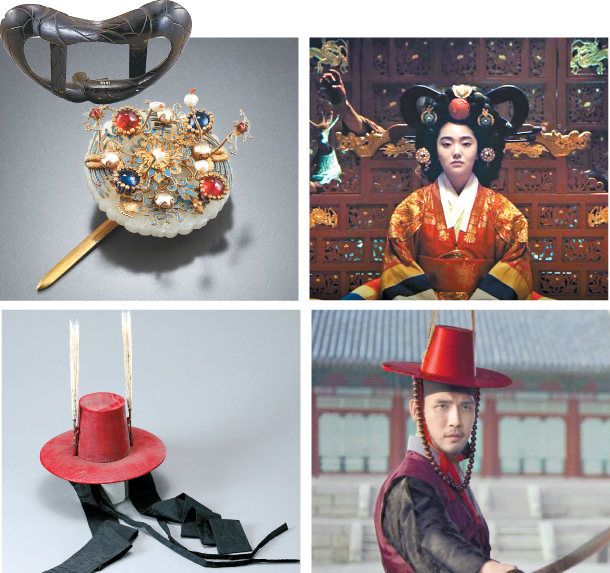Breaking down the hats and hairstyles of ‘Kingdom’: The hit Netflix series has viewers curious about Joseon-era accessories

Gat: The representative hat of the Joseon era was worn outdoors by aristocrats. [NETFLIX]

A tweet about Netflix’s “Kingdom” comments on Joseon-era hats. [SCREEN CAPTURE]
Viewers of the series, however, could not help themselves from being distracted by the “amazing hats” worn by the characters. One Twitter post following the show’s premiere in January read, “Netflix’s ‘Kingdom’ is so damn good. And the best part of the show, of course, is the hats.”
In the series, men are shown wearing a variety of hats, all in different shapes, sizes and colors depending on where they are going or what their social status is. Women, meanwhile, seldom wear hats; instead, they are shown with different hairstyles.
In an interview with the JoongAng Ilbo, costume design director Kwon Yoo-jin, who was in charge of the characters’ costumes in the series, said, “Since ‘Kingdom’ is a fictional series about zombies, we did not specify the time period, but the series is set around the middle of Joseon era.”

Actor Ryu Seung-ryong wears jeongjagwan, a hat worn by upper-class scholars at home, top. Actor Ryu and other government officials wore round hats, called samo during work, above.
From commoners to noble scholars, nearly all men of the Joseon era wore hats. According to “Joseon Era Hat Dictionary” author Yang Jin-sook, a professor in the department of textile design at Hanyang University, these hats were not usually worn for practical reasons, such as protecting someone from the sun. Instead, they reflected Confucian values — formality, authority and dignity — which was the foundations of politics at the time.
According to Jeong Jae-hak, director of liberal arts at the Cheonan Museum, who was one of the organizers of an exhibition titled “Hat, Perfection of Dignity,” wearing a hat was a sign of dignity.
“From a philosophical perspective, people at the time considered their hair to be equivalent to the mountains and the sky. Mountains were considered ‘high’ and ‘honorable’ so wearing a hat was like having this honor bestowed upon their heads. From a practical perspective, hats were meant to show one’s social class. Just by looking at the hats, people could distinguish whether a person was a girl or a boy, or a high-class scholar or a commoner who worked in the fields.”
People from different social class wore different forms of headgear. Society at the time was divided in four main classes: yangban (nobility and aristocrats), jungin (middle class), pyeongmin (commoners) and cheonmin (outcasts).
Eventually, hats came to have different sizes, shapes and purposes — there were indoor and outdoor hats, as well as hats for work and others worn for funerals or special ceremonies.

Saeang Hair: Actor Bae Doo-na, a doctor’s apprentice, has her hair tied back and braided with a red ribbon, typically worn by court ladies.
In “Kingdom,” the crown prince is seen wearing a gat wherever he goes — even when he is fighting against zombies.
Characterized by a wide, black brim with a cylinder top made of horse hair, gat went through different variations over the years. Discussions about the hat’s shape were first made during King Seongjong’s rule (1457-94), as written in the Annals of the Joseon Dynasty. According to the annals, the gat was characterized by a “round top and broad brim.” But by the end of King Yeonsangun’s reign (1494-1506), the hat began to have a cylinder-shaped top. The height of the top and the brim, however, changed over time, from short to tall. Eventually, the shape that people are familiar with today was worn during King Yeongjo and King Jeongjo’s rule (1724-1800).
Aristocrats also embellished their gat with ivory, agate or bamboo beads as gat straps, which became a symbol of extravagance and wealth.
In “Kingdom,” Ryu’s character and other officials in the palace are seen wearing jeongjagwan, an indoor headdress with multiple peaks that resembles a mountain, or samo, a round hat. Both were influenced by hats worn by Chinese officials. Jeongjagwan, made of horse hair and lacquered in black, was worn by upper-class men at home instead of gat, which were considered inconvenient to wear at home.
During work, however, government officials had to wear samo, a black hat with a low front and a high back, as part of their uniform. Samo were worn by officials since the Goryeo era (918-1392). The surface of the hat is made of horsehair and bamboo and covered with sandpaper. White versions of samo also existed, but these were worn during periods of mourning someone’s death. Middle class and commoners were often allowed to wear them during weddings.
Perhaps one of the most eye-catching hats in the series are those worn by military officials. Actor Jung Suk-won, a high-ranking military official, wears jeollip, which, depending on the type, is made of fur and wool, and sometimes adorned with a peacock feather on the top and an amber-beaded strap.
Civil and military officers also wore hats called jurip, lacquered in red and adorned with a tiger’s whiskers. They often matched their military uniforms called yungbok. By the end of the Joseon Dynasty, these hats were mostly worn by shamans.

Queens and noble married women wore large wigs called gache, attached to a wooden head piece called tteoguji, top. Civil and military officers are shown wearing red hats, adorned with tigers’ whiskers, above. [NATIONAL FOLK MUSEUM OF KOREA, NETFLIX, SCREEN CAPTURE]
In “Kingdom,” women are not shown wearing hats, but instead, they adorn their hair in different styles or using decorations, depending on their social status. Since the Joseon Dynasty was male-dominated, many women often stayed home doing house chores.
The queen in the series, played by actor Kim Hye-jun, is seen with her hair tied back in a chignon decorated with a hairpin called cheopji, or has her hair knotted up and held up with a gache (large wig).
Early in the series, Kim’s character wears her hair tied with cheopji, which were often made of silver or gold and were decorated with different animals, including frogs, peacocks, ducks and also flowers. Meanwhile, commoners wore hair ornaments made of wood.
In later episodes, as she moves to cement her power, she puts her hair up, supported by a large wig and a red, silk-made coronet called jokduri. The hairstyle, only allowed to be worn by high class married women, was a symbol of authority and extravagance. They were also decorated with fancy accessories called tteoljam, usually shaped like butterflies or flowers.
During ceremonial events, such as weddings, the queen or other high class ladies wore wooden butterfly-shaped headgear called tteoguji behind their hair.
The use of gache was banned in 1756 during King Yeongjo’s rule (1724-76) because they were considered “too extravagant” and heavy — they weighed around three to four kilograms (6 to 8 pounds).
A common hairstyle worn by court ladies was the saeang hair, characterized by a braid in the back supported with a red ribbon called daenggi. Actor Bae, who plays the role of a doctor’s apprentice and later escorts the crown prince, as well as most of the court ladies who appear in the series, is shown with this hair style.
The good news for fans of the show is that they will be able to see the stylish Joseon hats and hairstyles once again because after the show’s hype, Netflix is already preparing a second season of the series starring the same actors.
BY YEO YE-RIM [yeo.yerim@joongang.co.kr]










with the Korea JoongAng Daily
To write comments, please log in to one of the accounts.
Standards Board Policy (0/250자)